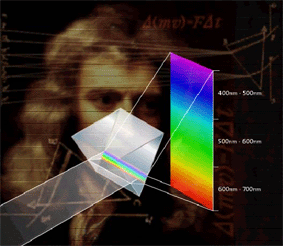It had been known for centuries that small fragments of colorless glass and precious stones glittered in bright colors when white light passed through them, but it was NOT until the middle of the seventeenth century that Sir Isaac Newton investigated the problem systematically.
Newton’s work on this subject arose out of the need for finding a way of removing coloration from the images seen through a telescope. At that time this instrument had recently been invented by a Dutch spectacle-maker named Hans Lippershey.
Newton’s experiment with a prism
Newton began his experiments by making a small hole in one of the window shutters of his room at Cambridge.
Light from the sun streamed through this hole and made a circular white patch on the opposite wall.
On placing a triangular glass prism before the hole, an elongated colored patch of light was formed on the wall. Newton called this a spectrum, and noted that the colors formed were in the order Red, Orange, Yellow, Green, Blue, Indigo and Violet.
Most people, however, are unable to distinguish the indigo from the rest of the blue.
Explanation of spectrum
The theory which put forward to explain the spectrum was that white light consists of a mixture of seven different colors. The refractive index of glass is different for each color, so that when white light falls on the prism each color in it is refracted at a different angle, with the result that the colors are spread out to form a spectrum.

It should be noted that when the light is incident on the prism as shown in the image, it is refracted towards the base of the prism, the violet being deviated most and the red least.
I think we can now define the term dispersion:
The separation of white light into its component colors by a prism is called dispersion.
Strictly speaking, there are many shades of each color in the spectrum, each shade merging gradually into the next.
Improvement on Newton’s Original experiment
The spectrum formed in Newton’s first experiment was impure. This resulted from the fact that it consisted of a series of circular colored images all overlapping.
Later Newton devised an arrangement, using two lenses in front of his prism, which produced a fairly pure spectrum.
How it is done?!
-
A converging lens is placed so as to form an image of a narrow slit brightly illuminated by white light.
-
A prism is then placed in the path of the light from the lens.
-
Now, dispersion of the light on passing through the prism leads to the formation of a spectrum on a white screen. This consists of a series of colored images of the slit all touching one another.
If the slit is made narrow, overlapping is reduced to a minimum and the resulting spectrum is fairly pure.
Production of pure spectrum. Spectrometer
A better method a pure spectrum than the one just described above is to use a parallel beam of light as in an instrument called a spectrometer.
This is used for examining the spectra of hot gases and other sources of light (as shown in the image above).
-
An illuminated slit is placed at the principal focus of a convex lens so that a parallel beam of light emerges from it and falls on a prism.
-
Refraction through the prism splits up the light into separate parallel beams of different colors, each of which is brought to its own focus in the focal plane of a second lens.
-
Here the spectrum may be formed on a white screen or, alternatively, viewed through a magnifying eyepiece.
The combination of slit and first lens is called collimator ( to collimate means to make parallel).
The second lens with cross wires in its focal plane, together with eyepiece form a telescope.
Recombination of the colors of the spectrum
The colors of the spectrum may be recombined to form white light by allowing the spectrum to be formed on a row of small rectangular plane mirrors ‘as shown in the image’.
On adjusting the angle which the mirrors make with the incident light so that they all reflect the light to the same place on the screen a white patch of light is formed.
But Newton did it in a different way
Newton showed the recombination of the colors to form white light in another way.
-
He painted the colors of the spectrum in sectors on a disc.
-
When rotated at high speed the disc appears white.
It is only fair to say the the whiteness thus obtained is slightly grayish, owing to the difficulty of obtaining pigments which are pure colors.
To understand the persistence of vision
The experiment works by reason of the “persistence of vision”. The impression of an image on the retina of the eye is retained for a small fraction of a second after the image has disappeared. Consequently, the brain sums up and blends together the rapidly changing colored images of the disc, and thus produces the sensation of a stationary white image.
It may be mentioned in passing that persistence of vision is responsible for the absence of flicker in the picture formed by a cine projector.
In this case
a constant succession of images of the film is thrown on the screen at the rate of 24 per second.
The eye retains the sensation of each image until it receives the next, so producing an impression of continuity.
This was the first part of the article. I hope it was useful.
I recommend you do read this article: electromagnetic waves illustration: origin and sources.
To be continue..:). .
